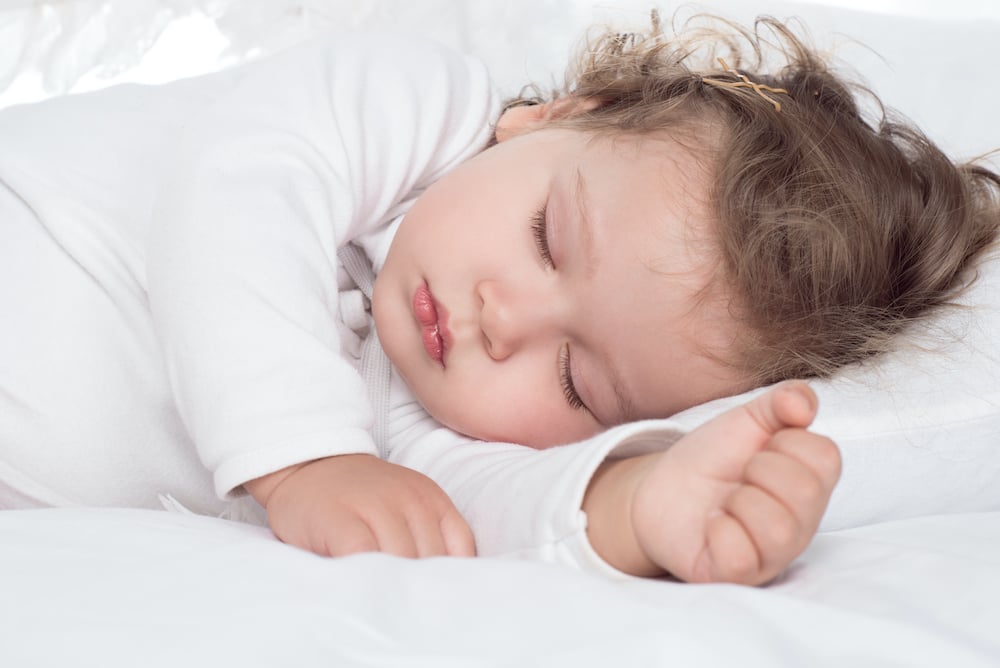How to Safely Use Lavender to Help Your Little One Sleep
While you should always be cautious with plant-based medicine, using lavender for babies and kids can be helpful when it comes to sleep and holistic healing. The key is age-appropriate use, proper dilution, and smart safety habits.

Throughout history, lavender has been used for perfume, washing, and even medicines. This lovely flower has long been used for skin issues, easing anxiety, and offering a better night’s sleep.
When it comes to using lavender with babies, safety and timing matter. A newborn’s body is still developing in ways we can’t always see, and something that feels harmless for an adult can be overwhelming for a tiny system. Let’s look at what the science says now and how to use lavender safely in your little one’s bedtime routine.
Is Lavender Essential Oil Safe for Babies?
Lavender is an herb known best for its ability to enhance relaxation and promote restful sleep. While you should always be cautious when using plant-based medicine, lavender can be used safely in infants and children.
Lavender (Lavandula angustifolia) is generally considered one of the mildest essential oils. Still, the youngest babies are especially sensitive, so experts recommend skipping essential oils entirely until at least 3 months of age. After that, you can begin introducing lavender in very light, cautious ways.
A few safety reminders:
- Commercially made lotions and soaps should contain only gentle ingredients that won’t add to your baby’s toxic burden.
- Never let a baby or small child ingest essential oils.
- For topical use, always dilute. A safe range for babies is around 0.25–0.5%. That means one drop of lavender in two to four teaspoons of a gentle carrier oil like jojoba, grapeseed, or fractionated coconut oil. Test on a small patch of skin and avoid applying to hands, faces, or broken skin.
- If your child has eczema, asthma, or very sensitive skin, it’s best to avoid essential oils directly and focus instead on fragrance-free skincare.
Sleep Patterns and the Circadian Rhythm
Babies aren’t born with an internal clock that knows day from night. Babies are in total darkness in the womb, so their internal clocks slowly develop after birth. That means that “sleeping like a baby” doesn’t come naturally to a baby.
After birth, their circadian rhythm takes a few months to begin functioning. Research shows that melatonin production and more predictable sleep-wake cycles usually start around 8–12 weeks.
This is why routines help so much. Predictable cues, like dimming the lights in the evening or offering a warm bath before bed, give your baby’s developing system a sense of rhythm. Adding lavender can be one more gentle signal that it’s time to slow down.
Adding a lavender sleep spray, bath salt, or essential oil to the bath routine can make this cue even more powerful. The lovely herb has a long reputation for promoting relaxation, calm moods, and better sleep.
Science even backs it up! One scientific study showed lavender was as effective against general anxiety disorder as medication (source). Others show that lavender can alleviate PTSD and postnatal depression.
Mood Benefits of Lavender
We can all appreciate pleasant smells, but lavender’s ability to calm and soothe isn’t just because of its flowery scent. The smell of cookies in the oven; simmering stews; fresh roses. We all have scents that strike a certain chord, and it’s because smell has a powerful tie to memory and emotions.
That’s because the nose has a direct path to the olfactory system, which has a direct connection to the limbic system of the brain. The limbic system performs a variety of important functions, with many of them involving emotions (thus its nickname the “emotional brain”).
Naturally, the emotional limbic system is connected to the areas of the brain that regulate blood pressure, hormones, breathing, and so on. We all know that emotions can have an immediate impact on the body. This is important to note, because the connection between the olfactory system and the limbic system means scent can also have an instant snap-effect on emotions. In fact, nostalgia and expectations alone can influence behavior (source).
Lavender and the Body
The benefits of high-grade lavender products go straight to the nose, but the skin gets them, too. Lavender is packed with soothing compounds that heal wounds, soothe allergic reactions, fight infection, and ease eczema. Studies show lavender reduces pain and itching from bug bites, bee stings, and burns. And lavender is so gentle and healing, it’s generally tolerated even by sensitive skin.
Beyond its calming scent, lavender has also been studied for its role in reducing inflammation and supporting skin repair. It can encourage tissue healing and bring comfort to irritated or sunburned skin when used in proper dilutions.
While we’re more cautious with babies (avoiding broken skin and always diluting carefully) lavender’s gentle, restorative properties are part of why it has been treasured in herbal medicine for centuries.
Safe Products that Contain Lavender
Just because a bottle of baby lotion touts purple moons on the label, it’s not automatically natural and safe for your little one. Many store brands still contain parabens, sulfates, propylene glycol, and other harmful ingredients.
These products use lavender for babies and kids safely:
Dr. Bronner’s Pure Castile Liquid Soap
Earth Mama Calming Lavender Body Wash & Shampoo
Zoey Naturals Soothing Lavender Lotion for Babies
Dried Lavender Flower Uses
Little ones love this lavender lemonade recipe. It’s both refreshing and relaxing. Plus it’s easy enough for kids to help make.
As a mother, you’re the emotional thermostat of your home. There’s nothing like a soothing cup of tea for your own wellbeing and to set the stage for a calm household. Lavender on its own is a bit strong for tea. This recipes balances it out nicely.
Lavender Chamomile Tea
- 1 teaspoon organic lavender flowers
- 1 teaspoon organic chamomile flowers
- 8 ounces hot water
Place lavender and chamomile into a tea strainer. Pour hot water over them. Allow to steep for about 10 minutes, add local honey if desired, and enjoy.
Fabric Softener Alternative
Most dryer sheets contain chemicals you don’t want near your little one’s skin. Make DIY dryer sachets by adding dried lavender flowers to small organza bags (you probably have some on hand from when you buy from small businesses). You can also use these as drawer fresheners. Or simply add a few drops of lavender oil to wool dryer balls.
Safe Ways to Use Lavender
While lavender can be a great natural baby sleep aid, sometimes the best way to help your baby relax is for you to feel calm. A warm lavender-chamomile tea (for you, not baby), a bath, or a dab of diluted oil on your wrist can set a peaceful tone for the whole household.
For babies under 3 months: Stick with non-scent cues like skin-to-skin contact, soft lighting, and white noise. Their developing systems don’t need essential oils just yet.
For babies 3–12 months: Try diffusing lavender across the room for 15–20 minutes before bedtime, then turn it off. If you prefer topical use, dilute carefully and apply only occasionally, avoiding areas of sensitive skin.
Add a few drops of lavender essential oil to a diffuser each evening. Diffusing essential oils around babies is safe, soothing and calming for everyone in your home.
DIY First Aid Ointment
The popular brand of antibiotic ointment uses a petroleum byproduct for its base, and petroleum isn’t one of the healthiest ways to heal a wound. Here’s a natural first-aid ointment you can make at home.
Ingredients
- 1/3 cup Organic Coconut Oil
- 1 tablespoon Organic Beeswax Pastilles
- 1/4 teaspoon Vitamin E Oil
- 10 drops Lavender Essential Oil
- 10 drops Tea Tree Oil
Directions
- Place coconut oil, Vitamin E oil, and beeswax in a double boiler. (You could also place a mason jar into a pot of water on the stovetop.)
- Stir gently until the mixture has become liquid and clear.
- Remove from heat and add 10 drops of each essential oil.
- Stir and pour into a sterilized glass storage container.
Lavender can be a lovely addition to your family’s bedtime rhythm, especially once your baby is past the newborn stage and their circadian rhythm is beginning to develop. Think of it as one more calming layer in a routine that already includes dim lights, a safe bedroom, gentle touch, and consistent cues.


Thank you for sharing valuable information. I got so much important informative knowledge from your blog.
I love natural products! I’ve been using some essential oils at home, including kids room, especially jasmine (which I love!) for sleep. I must try lavender now. We have good routine settled and since the gentle sleep training (I recommend Susan’s parental-love blog and books) we don’t really have trouble sleeping. But it’s always good to add something new and nice to the routine. Will see how it goes!
High five to Susan’s sleep training guide! I loved her book and it helped be to stay sane. Also it was so easy to follow with her step-by-step form. Just brilliant!
That’s super interesting! I’m just starting establishing bedtime routine following How to teach a baby to fall asleep alone guide. Susan Urban says nothing about it but maybe we could ad some rubbing to the basic set! I’m going to test it tomorrow!
We rub lavender oil on our daughters feet before bedtime. It tends to help her get to sleep just a little faster 🙂